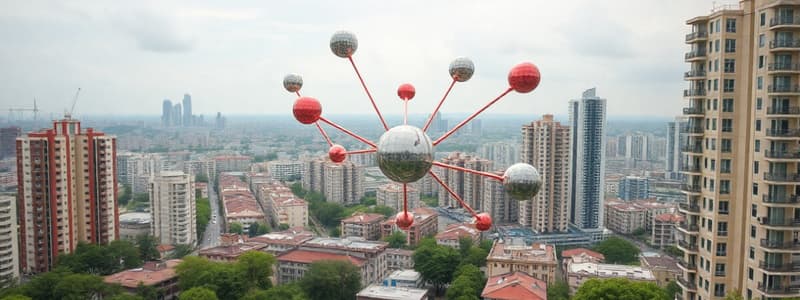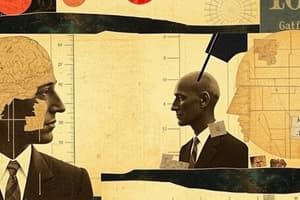Podcast
Questions and Answers
Who proposed the Multiple Nuclei Theory?
Who proposed the Multiple Nuclei Theory?
- Homer Hoyt
- Patrick Geddes
- Harris and Ullman (correct)
- Ernest Burgess
In which year was the Multiple Nuclei Model introduced?
In which year was the Multiple Nuclei Model introduced?
- 1925
- 1950
- 1945 (correct)
- 1939
According to the Multiple Nuclei Theory, a city develops around:
According to the Multiple Nuclei Theory, a city develops around:
- Multiple independent centers (correct)
- A linear corridor
- One central nucleus
- Only transport hubs
What is the primary reason for the emergence of multiple nuclei in a city?
What is the primary reason for the emergence of multiple nuclei in a city?
Which of the following are considered as nuclei according to the model?
Which of the following are considered as nuclei according to the model?
What allows for greater decentralization in the Multiple Nuclei Model?
What allows for greater decentralization in the Multiple Nuclei Model?
Which of the following is NOT a reason for separate nuclei in the Multiple Nuclei Model?
Which of the following is NOT a reason for separate nuclei in the Multiple Nuclei Model?
In the Multiple Nuclei Model, why are airports kept away from residential zones?
In the Multiple Nuclei Model, why are airports kept away from residential zones?
What type of urban model is the Multiple Nuclei Theory considered as?
What type of urban model is the Multiple Nuclei Theory considered as?
Which of the following activities tend to group together in this model?
Which of the following activities tend to group together in this model?
Which model supports the existence of multiple business centers in a city?
Which model supports the existence of multiple business centers in a city?
Which type of cities is best explained by the Multiple Nuclei Model?
Which type of cities is best explained by the Multiple Nuclei Model?
In the Multiple Nuclei Model, what kind of development pattern does the city follow?
In the Multiple Nuclei Model, what kind of development pattern does the city follow?
Which activities are usually separated in the Multiple Nuclei Model?
Which activities are usually separated in the Multiple Nuclei Model?
Which of the following best explains the advantage of the Multiple Nuclei Model?
Which of the following best explains the advantage of the Multiple Nuclei Model?
What type of city form is best represented by the Multiple Nuclei Theory?
What type of city form is best represented by the Multiple Nuclei Theory?
One of the criticisms of the Multiple Nuclei Theory is:
One of the criticisms of the Multiple Nuclei Theory is:
Which would NOT likely be located near each other in the Multiple Nuclei Model?
Which would NOT likely be located near each other in the Multiple Nuclei Model?
Which factor influences the formation of a new nucleus in the Multiple Nuclei Model?
Which factor influences the formation of a new nucleus in the Multiple Nuclei Model?
What is a major difference between the Concentric Zone Model and the Multiple Nuclei Model?
What is a major difference between the Concentric Zone Model and the Multiple Nuclei Model?
Flashcards
Multiple Nuclei Theory
Multiple Nuclei Theory
Developed by Harris and Ullman, this theory posits that cities grow around several independent nuclei rather than a single central business district.
Year of Model Introduction
Year of Model Introduction
The Multiple Nuclei Model was introduced in 1945, offering an alternative to earlier, more centralized urban models.
Urban Development Pattern
Urban Development Pattern
Cities develop around multiple independent centers or nuclei, each serving different functions.
Reasons for Multiple Nuclei
Reasons for Multiple Nuclei
Signup and view all the flashcards
Examples of Nuclei
Examples of Nuclei
Signup and view all the flashcards
Factors Enabling Decentralization
Factors Enabling Decentralization
Signup and view all the flashcards
NOT a reason for separate nuclei
NOT a reason for separate nuclei
Signup and view all the flashcards
Airport Location Rationale
Airport Location Rationale
Signup and view all the flashcards
Type of Urban Model
Type of Urban Model
Signup and view all the flashcards
Activities Grouping Together
Activities Grouping Together
Signup and view all the flashcards
Multiple Business Centers
Multiple Business Centers
Signup and view all the flashcards
Cities Best Explained
Cities Best Explained
Signup and view all the flashcards
Development Pattern
Development Pattern
Signup and view all the flashcards
Activities Usually Separated
Activities Usually Separated
Signup and view all the flashcards
Advantage of Model
Advantage of Model
Signup and view all the flashcards
Type of City Form
Type of City Form
Signup and view all the flashcards
Criticism of the Theory
Criticism of the Theory
Signup and view all the flashcards
Unlikely Locations
Unlikely Locations
Signup and view all the flashcards
Formation of New Nucleus
Formation of New Nucleus
Signup and view all the flashcards
Difference from Concentric Zone Model
Difference from Concentric Zone Model
Signup and view all the flashcards
Study Notes
- The Multiple Nuclei Theory was proposed by Harris and Ullman.
- This theory was introduced in 1945.
- According to the Multiple Nuclei Theory, a city develops around multiple independent centers.
- The primary reason for the emergence of multiple nuclei in a city is historical and situational factors.
- Universities, airports, and ports are considered as nuclei.
- Car ownership and improved transportation allows greater decentralization in the Multiple Nuclei Model.
- Planning laws is NOT a reason for separate nuclei in the Multiple Nuclei Model.
- Airports are kept away from residential zones because of high noise and pollution.
- The Multiple Nuclei Theory is considered an ecological urban model.
- Universities, bookstores, and coffee shops tend to group together.
- This model supports the existence of multiple business centers in a city.
- The Multiple Nuclei Model best explains large and growing cities.
- In the Multiple Nuclei Model, the city follows a polycentric development pattern.
- Heavy industries and housing are usually separated in the Multiple Nuclei Model.
- The advantage of the Multiple Nuclei Model is that it allows cities to grow in a decentralized, flexible manner.
- The Multiple Nuclei Theory best represents a multi-core or polycentric city form.
- One of the criticisms is that it can be too complex and lacks defined boundaries.
- A factory and residential suburb would NOT likely be located near each other based on this model.
- Specific functional needs and location advantages influences the formation of a new nucleus in the Multiple Nuclei Model.
- A major difference between the Concentric Zone Model and the Multiple Nuclei Model is the presence of a single CBD.
Studying That Suits You
Use AI to generate personalized quizzes and flashcards to suit your learning preferences.




